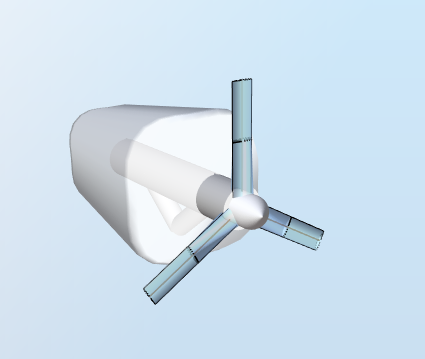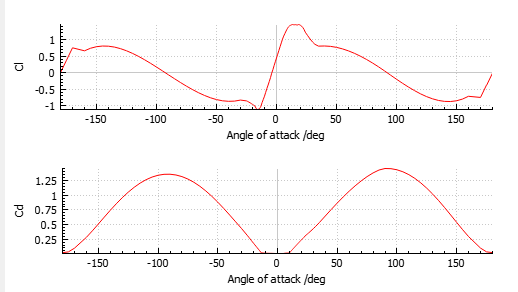One airfoil blade
1 Test description
This test uses a simple blade with few aerodynamical blade stations in steady conditions and compares the aerodynamical loads computed by Ashes to an analytical solution.
The following load cases are tested
- 10 ms
- 5 ms
- 10 ms RPM 10
- 10 ms - unsteady BEM
- 5 ms - unsteady BEM
- 10 ms RPM 10 - unsteady BEM
- 10 ms pitch 20
- 5 ms pitch 20
- 10 ms RPM 10 pitch 20
- 10 ms pitch 20 - unsteady BEM
- 5 ms pitch 20 - unsteady BEM
- 10 ms RPM 10 pitch 20 - unsteady BEM
- 10 ms twist
- 5 ms twist
- 10 ms RPM twist
- 10 ms twist - unsteady BEM
- 5 ms twist - unsteady BEM
- 10 ms RPM 10 twist - unsteady BEM
2 Model
This test uses the RNA only template
The CSV file to run this test can be downloaded from here.
The model used for this test is shown in the figure below:

The chordlength accross the blade is
$$c = 1\text{ m}$$
, the blade length is $$L = 5\text{ m}$$
and the hub radius is $$r_h = 0.5\text{ m}$$
.The blade used for this model has three Blade aerodynamical station . The innermost station is at the root and has a cylindrical airfoil with no drag and no lift. This station will therefore not produce any aerodynamic loads.
The two other blade aerodynamical stations have the NACA64-618 airfoil, which polar can be exported from Ashes and are shown in the figure below:

This test uses two variants of this blade:
- one variant has no twist (when the pitch is 0, the chordline of each blade station is in the rotor plane)
- one variant has twist, as shown in the table below
The table below gives a summary of the relevant blade characteristics:
| Blade aerodynamical station | Distance to blade root | Influence length | Airfoil | Twist (if applicable) |
| 1 | $$r_1 = 0$$ | $$L_{I1} = 1.25\text{ m}$$ | Cylinder with no lift and drag | $$\theta = 0$$ |
| 2 | $$r_2 = 2.5\text{ m}$$ | $$L_{I2} = 2.5\text{ m}$$ | NACA64-618 | $$\theta = 20\text{ deg}$$ |
| 3 | $$r_3 = 5\text{ m}$$ | $$L_{I3}=1.25\text{ m}$$ | NACA64-618 | $$\theta = 5\text{ deg}$$ |
The air density is
$$\rho = 1.225\text{ kg}\cdot{m}^{-3}$$
. No gravity forces are applied, and tip and hub corrections are set to 0. The simulations are run in Loads only mode (see Analysis), so the blade will not experience deflections and the rotational speed will not vary.3 Analytical solution
The wind speed and rotational speed are denoted
$$V$$
and $$\omega$$
, respectively.In order to compute the aerodynamic loads, we need to find the lift and drag coefficients for a given blade station. We do this using the steady BEM algorithm defined by Hansen (2008d) and summed up below:
- define initial axial and tangential induced velocities as $$a = 0.33$$and$$a_t = 0$$, respectively
- the flow angle is defined as $$\phi = \tan^{-1}\frac{(1-a)\cdot V}{(1+a_t)\cdot\omega\cdot(r+r_h)}$$
- the angle of attack is obtained by substracting the twist $$\theta$$and the pitch$$\gamma$$to the flow angle. The angle of attack is thus$$\alpha = \phi-\theta-\gamma$$
- the lift and drag coefficients $$C_L$$and$$C_D$$are then looked up from the polars. Linear interpolation is used if the current angle of attack is not in the look-up table.
- the blade solidity is calculated as $$\sigma = \frac{cB}{2\pi(r+r_h)}$$, where$$B = 1$$is the number of blades
- new values for the induced velocities are computed as$$a = \frac{1}{\frac{4\sin^2\phi}{\sigma C_n}+1}$$and$$a_t = \frac{1}{\frac{4\sin\phi\cos\phi}{\sigma C_t}+1}$$
where$$C_n = C_L\cos\phi+C_D\sin\phi$$and$$C_t = C_L\sin\phi - C_D\cos\phi$$ - compare the induced velocities to the previous values. If the difference is larger than 0.001, repeat steps 2 to 6
- the relative velocity is defined as $$V_{rel}=\sqrt{((1-a)\cdot V)^2+((1+a_t)\cdot\omega\cdot(r+r_h))^2}$$
- the lift and drag forces, for blade station $$i$$are then$$F_{D,i} = \frac{1}{2}\rho cC_DV_{rel}^2$$and$$F_{L,i} = \frac{1}{2}\rho cC_LV_{rel}^2$$
- the thust and torque forces are then$$F_{th,i} = F_{L,i}\cos\phi+F_{D,i}\sin\phi$$and$$F_{t,i} = -F_{D,i}\cos\phi + F_{L,i}\sin\phi$$
More details on the theory and the equations can be found in the BEM algorithm section.
The aerodynamic thrust for the whole rotor is
$$F_T = \sum_{i=2}^3F_{th,i}\cdot L_{I,i}$$
and the aerodynamic torque for the whole rotor is $$T=\sum_{i=2}^3 F_{t,i}\cdot L_{Ii}\cdot (r_i+r_h)$$
. These two output can be found in the Rotor sensor. The next three output are part of the Blade [Time] sensor sensor. The root force is the sum of the drag and the lift forces from both stations, which can be expressed as
$$F_r = \sum_{i=2}^3\sqrt{F_{D,i}^2+F_{L,i}^2}$$
. The in-plane bending moment is $$M_{ip}=\sum_{i=2}^3 F_{t,i}\cdot L_{Ii}\cdot r_i$$
and the out-of-plane bending moment is $$M_{oop}\sum_{i=2}^3F_{th,i}\cdot L_{Ii}\cdot r_i$$
This derivation is used for all the load cases run in this test. The table below sums up the expected results.
| Test name | Description | Aerodynamic thrust $$[\text{N}]$$ | Aerodynamic torque $$[\text{Nm}]$$ | Root force $$[\text{N}]$$ | In plane bending moment $$[\text{Nm}]$$ | Out of plane bending moment $$[\text{Nm}]$$ | Cl $$[\text{-}]$$ | Cd $$[\text{-}]$$ |
| 10 ms | Wind speed = 10 RPM = 5 | 305.4 | 37.64 | 305.6 | 32.72 | 1030 | 0.2804 | 1.3854 |
| 5 ms | Wind speed = 5 RPM = 5 | 81.22 | 8.859 | 81.25 | 7.708 | 278.3 | 0.4660 | 1.266 |
| 10 ms RPM 10 | Wind speed = 10 RPM = 10 | 324.9 | 35.44 | 325.0 | 30.83 | 1113 | 0.4660 | 1.266 |
| 10 ms pitch 20 | Wind speed = 10 RPM = 5 Pitch angle = 20 | 255.4 | 387.0 | 274.4 | 336.8 | 857.9 | 0.6608 | 1.062 |
| 5 ms pitch 20 | Wind speed = 5 RPM = 5 Pitch angle = 20 | 65.65 | 99.48 | 70.46 | 86.68 | 222.5 | 0.7556 | 0.8831 |
| 10 ms RPM 10 pitch 20 | Wind speed = 10 RPM = 10 Pitch angle = 20 | 262.6 | 397.9 | 281.9 | 346.7 | 890.2 | 0.7556 | 0.8831 |
| 10 ms twist | Wind speed = 10 RPM = 5 Blade with twist | 270.9 | 264.4 | 282.0 | 225.3 | 935.4 | 0.6608 | 1.062 |
| 5 ms twist | Wind speed = 5 RPM = 5 Blade with twist | 71.16 | 67.40 | 73.86 | 57.52 | 250.1 | 0.7556 | 0.8831 |
| 10 ms RPM 10 twist | Wind speed = 10 RPM = 10 Blade with twist | 284.7 | 269.6 | 295.4 | 230.1 | 1000 | 0.7556 | 0.8831 |
Note: since the conditions are steady, it is expected that the unsteday BEM and the steady BEM will give very similar results.
4 Results
A simulation of ten seconds is run. The test is considered passed if the last two seconds of the results produced by Ashes lie within 1% of the analytical solution.
The report with the results can be found here: